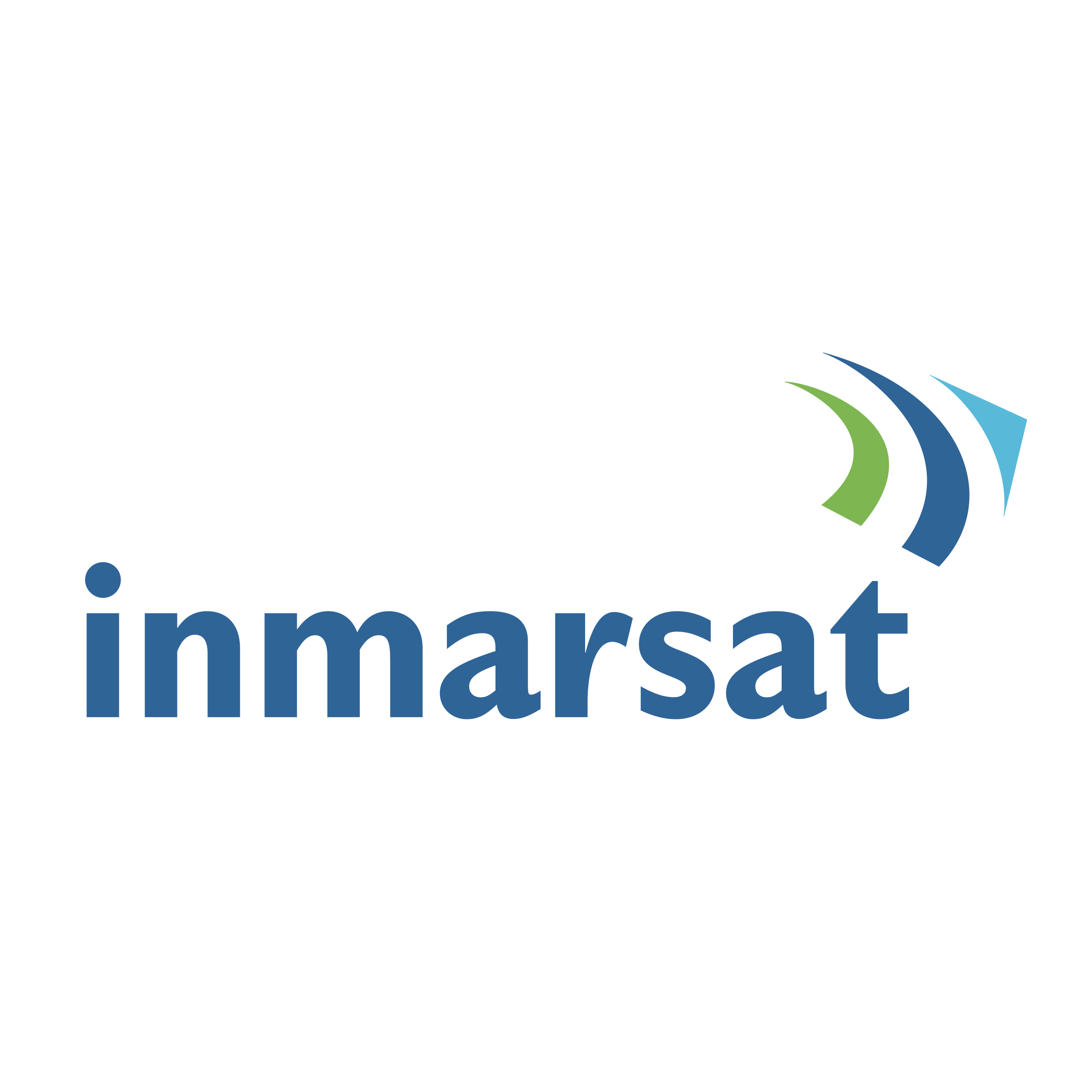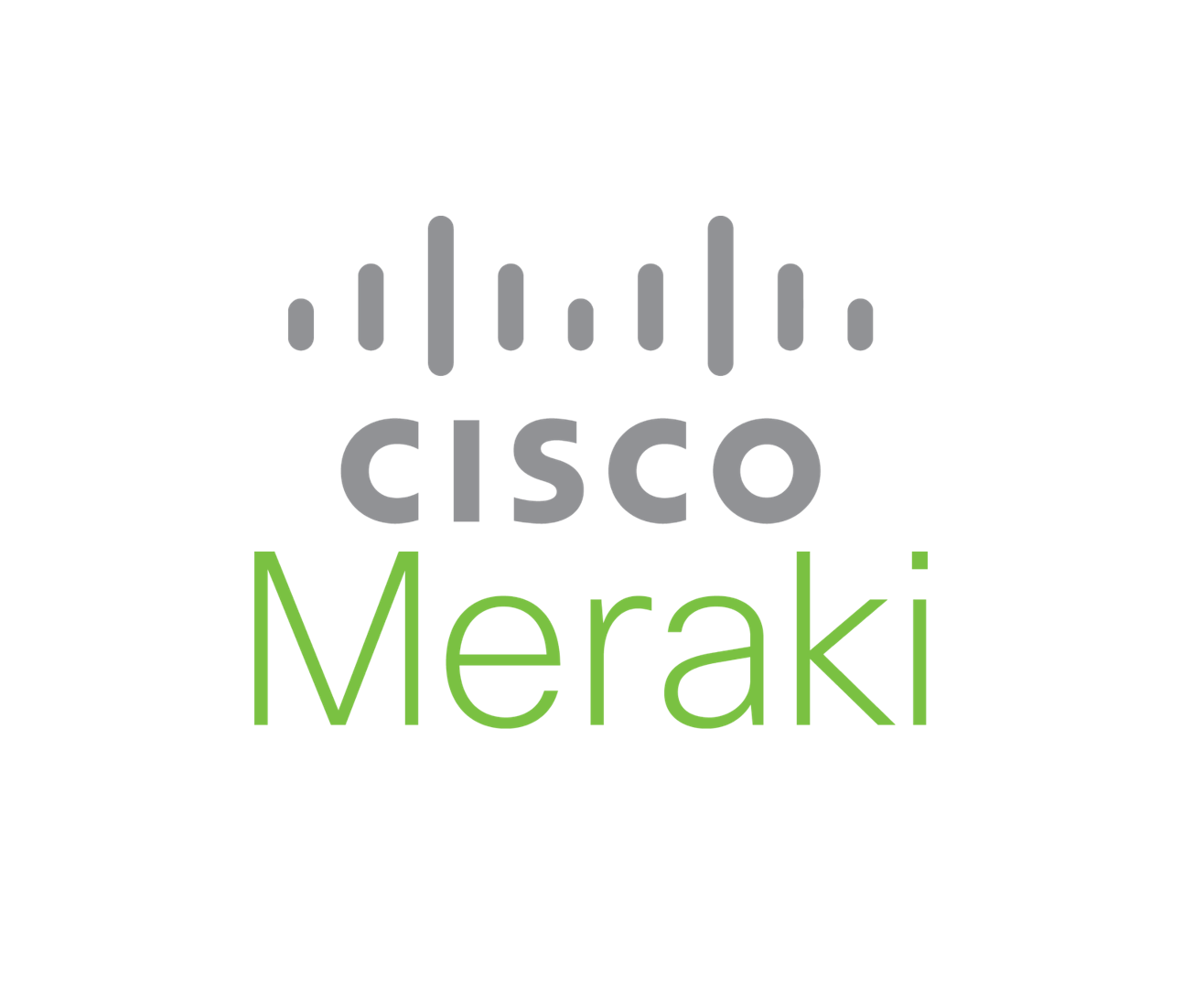Partners
Network Partners

Inmarsat was set up by the International Maritime Organization (IMO) in 1979 to provide a satellite communications network that would protect the lives of mariners anywhere at sea. Inmarsat was the first satellite operator to meet the stringent requirements of the Global Maritime Distress and Safety System (GMDSS) and the International Civil Aviation Organization (ICAO) for global safety communications. Inmarsat has been connecting people for almost 40 years, and the world’s leading provider of global mobile satellite communications Inmarsat customers range from governments and aid agencies to ship owners and airlines – what they share is a need to stay connected at all times, no matter where they are. Inmarsat wide range of mobile and fixed satellite communication solutions and partners’ value-added applications deliver all the connectivity they need when they are beyond the reach of terrestrial networks.
Inmarsat network
Inmarsat BGAN network offers seamless global coverage and unrivalled satellite and ground network availability of over 99.9 per cent. Through L-band services,Inmarsat connect people and machines in remote locations, on board ships and in planes – enabling the global Internet of Things (IoT), voice calls and internet access – for everything from email and web browsing to high bandwidth applications such as live streaming and telemedicine.
Global Xpress (GX) is the first mobile high-speed broadband network from a single, trusted provider to span the world. As well as increased bandwidth,Inmarsat Ka-band service offers content-rich applications from certified developers.
inmarsat Satellites
Inmarsat owns and operate a total of 13 satellites flying in geostationary orbit 35,786km (22,236 miles) above the Earth. Together Inmarsat delivers global maritime and aviation safety, L-band broadband, high-speed Ka-band, and European inflight Wi-Fi S-band services.
Inmarsat-3
The first generation to use spot-beam technology, the Inmarsat-3 L-band satellites were launched between 1996-98 to power maritime and aviation communication and safety services.Although three of the five satellites are still in service, Inmarsat is migrating operational services across to its I-4 fleet throughout 2018.
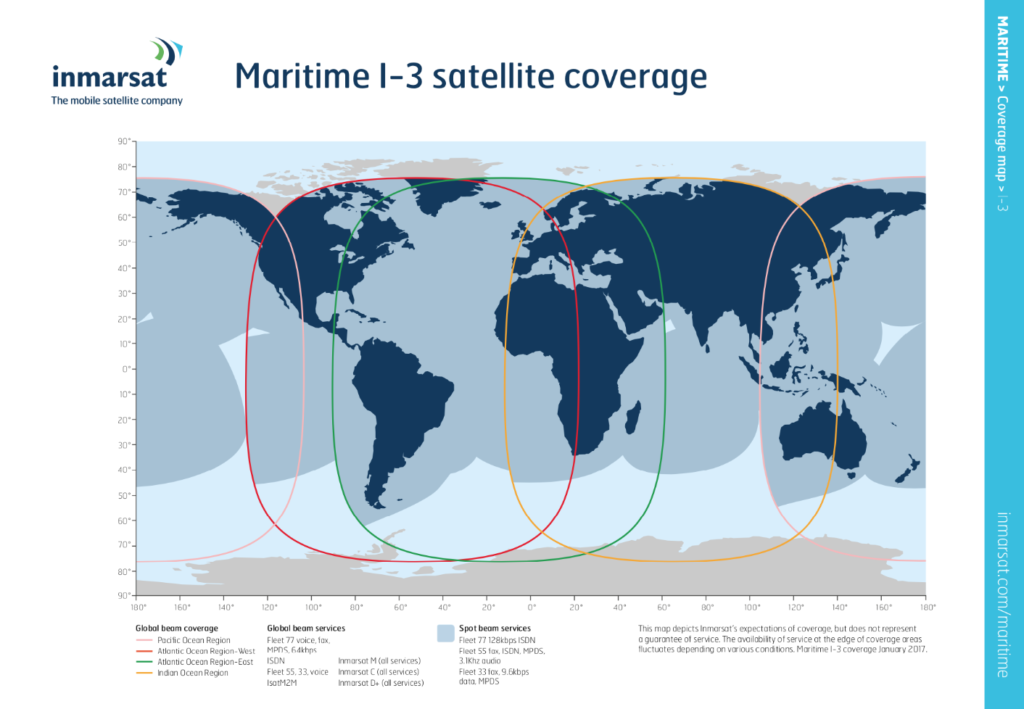
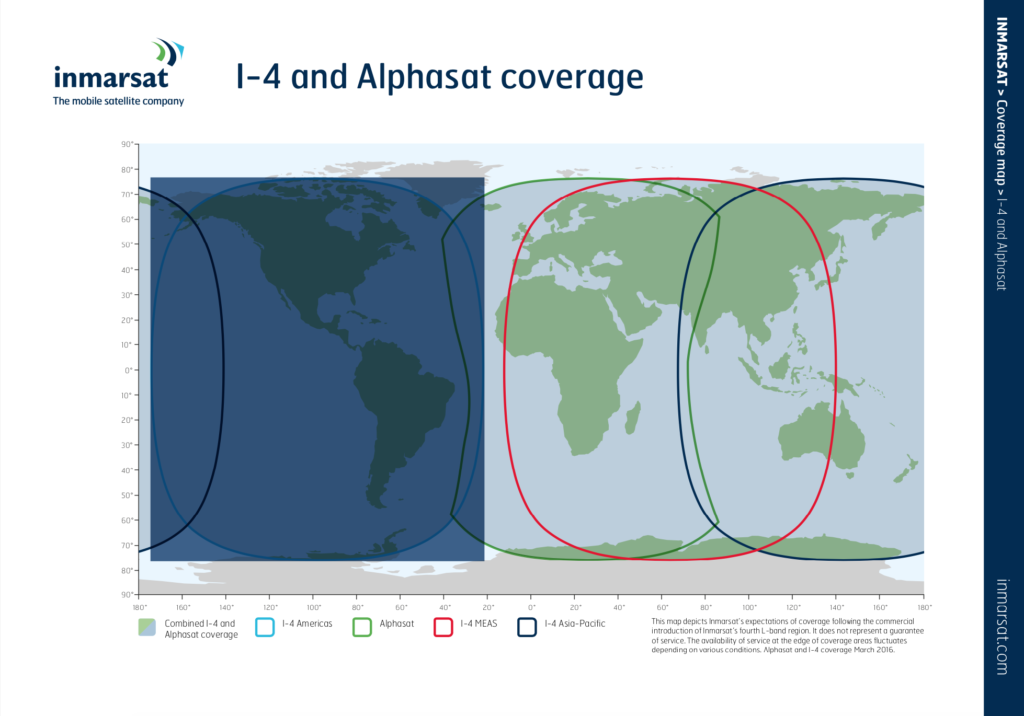
Inmarsat-4
nmarsat-4 (I-4) series of satellites established the world’s first global 3G mobile network. They are responsible for delivering L-band broadband services, including BGAN, FleetBroadband and SwiftBroadband, as well as IoT and voice services. The first three Inmarsat-4 (I-4) satellites were launched into geostationary orbit from 2005-8. They were built by an international team of space technologists from the United Kingdom, France, Germany, the USA and Canada, with European satellite manufacturer EADS Astrium as the lead contractor. In July 2013 Inmarsat launched Alphasat (I-4A F4) to supplement the I-4 fleet, providing coverage over Europe, the Middle East and Africa from its in-orbit location at 25° East. Alphasat, at the time the largest European telecommunications satellite ever built, brought new capabilities including 50 per cent more accessible L-band spectrum and nearly 20 per cent more mobile communication channels.
inmarsat-5
Inmarsat’s fifth generation, Ka-band satellites power Global Xpress (GX) – the world’s first and only globally available, mobile, high-speed broadband service delivered through a single, wholly-owned network to ensure seamless connectivity. GX is transforming whole industries by offering highly reliable, fully scalable connectivity solutions for users on land, at sea, and in the air. The Inmarsat-5 (I-5) satellites were built by US manufacturer Boeing, based on its powerful 702HP platform. The first three I-5 satellites were launched between December 2013 and August 2015, with global commercial service starting in December 2015. A Very High Throughput Satellite (V-HTS), constructed by Thales Alenia Space, will boost GX capacity even further across key geographical areas. The combination of the latest satellite technology and a focus on areas of high demand will further enhance the customer experience. The fifth I-5 satellite is targeted for launch at the end of 2019.
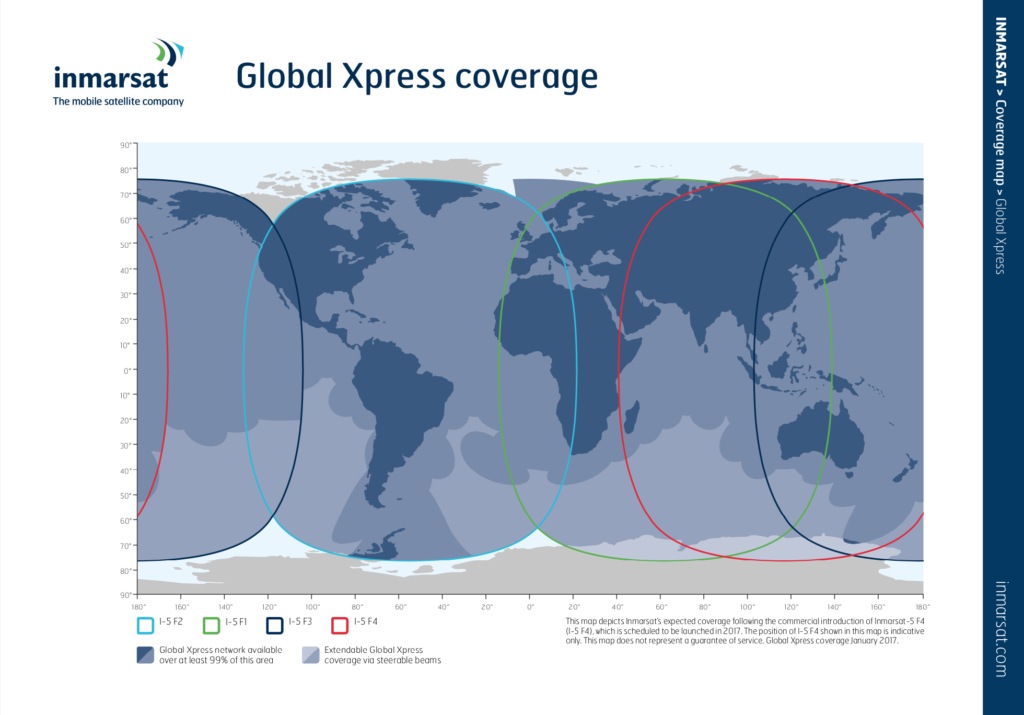

Global Communications
Iridium powered by a uniquely sophisticated global constellation of 66 cross-linked Low Earth Orbit (LEO) satellites which provides connectivity from pole to pole. The Iridium® network provides high-quality voice and data connections over the planet’s entire surface, including across oceans, airways and polar regions.
Iridium is the only satellite communications company that offers truly global voice and data communications coverage. A technology innovator and market leader, Iridium, in collaboration with its partner network, is advancing the way global enterprises conduct daily mission-critical activities through reliable, low-latency communications services.
Iridium’s 66 low-Earth orbiting (LEO) cross-linked satellites – the world’s largest commercial constellation – operate as a fully meshed network.
Reaching across land, sea, and air, including the polar regions, Iridium® solutions are ideally suited for industries such as maritime, aviation, government/military, emergency/humanitarian services, mining, forestry, oil and gas, heavy equipment, transportation and utilities. Iridium also provides service to subscribers from the U.S. Department of Defense, as well as other civil and government agencies around the world.
IRIDIUM NEXT
Iridium NEXT completed deployment in 2018, Iridium NEXT enables a superior platform to support Iridium’s partners and bring enhanced and innovative new services and capabilities to our customers, such as Iridium Certus℠. Iridium Certus will enable enterprise-grade satellite broadband communications across a variety of industries, revolutionizing the way businesses operate and communicate. With Iridium NEXT, Iridium’s groundbreaking second-generation constellation, Iridium is set to dramatically improve its ability to meet the growing demand for global mobile communications on land, at sea and in the skies — far into the future.
Delivering global, reliable and enterprise-grade services while redefining the capabilities of satellite communications, Iridium CertusSM is the new service platform to be powered by the $3 billion Iridium NEXT satellite system. Iridium Certus will offer more than just connectivity – it is a portfolio of ever-expanding service offerings that will allow your business to operate more efficiently by providing more value and coverage than any other satellite operator.
With a range of speeds eventually up to 1.4 megabits per second after Iridium NEXT deployment is completed, Iridium Certus is being built to support an innovative portfolio of partner products and satisfy a wide-ranging set of maritime, aviation and land mobile.

Inmarsat was set up by the International Maritime Organization (IMO) in 1979 to provide a satellite communications network that would protect the lives of mariners anywhere at sea. Inmarsat was the first satellite operator to meet the stringent requirements of the Global Maritime Distress and Safety System (GMDSS) and the International Civil Aviation Organization (ICAO) for global safety communications. Inmarsat has been connecting people for almost 40 years, and the world’s leading provider of global mobile satellite communications Inmarsat customers range from governments and aid agencies to ship owners and airlines – what they share is a need to stay connected at all times, no matter where they are. Inmarsat wide range of mobile and fixed satellite communication solutions and partners’ value-added applications deliver all the connectivity they need when they are beyond the reach of terrestrial networks.
Thuraya's coverage footprint
With roaming agreements established in 161 countries, Thuraya is able to provide reliable roaming services for postpaid and prepaid customers onto more than 395 worldwide GSM networks. GSM subscribers from those networks can also insert their GSM SIM into a Thuraya handset to enjoy roaming services across Thuraya’s satellite network, in order for them to remain connected when they are out of GSM coverage.
Thuraya offers an emergency service which will send SMS messages with the actual GPS location and alarm-status to predefined destinations. The organization provides data and voice satellite communications solutions in remote locations for the energy, media, government, NGO and maritime sectors.
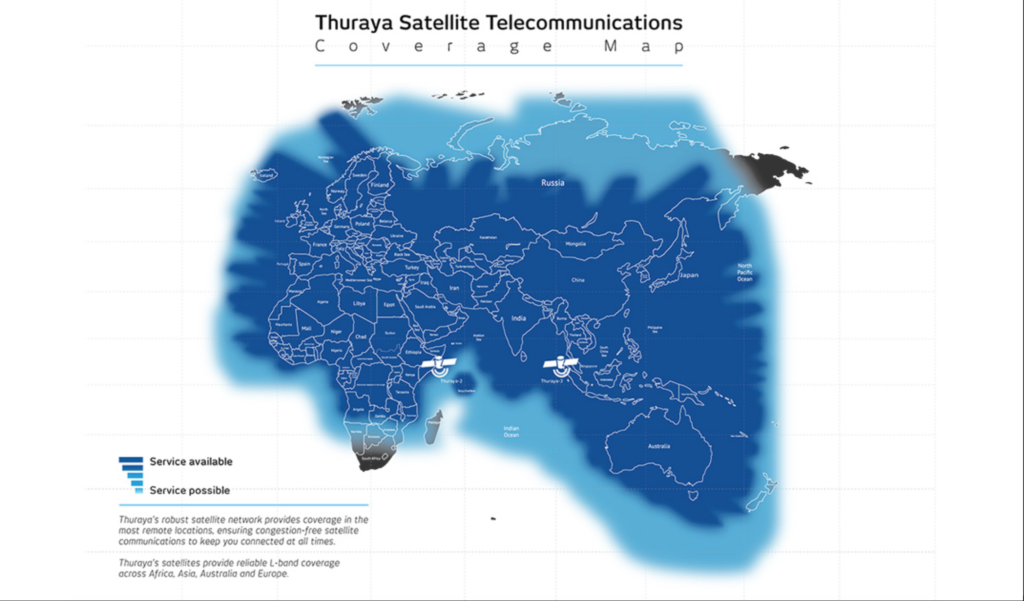
Product Availability
All Thuraya satellite products and services are available through UStronics. We offer and deliver Thuraya Land, Maritime, Aviation and M2M solutions to our customers worldwide. Thuraya phones, such as X5-Touch, XT-Pro Dual, SatSleeve+, Satsleeve Hotspot, XT Pro, and XT Lite, in addition to IP terminals, indoor repeaters, for maritime use the Seagull series, as well as accessories, airtime refill codes and services, even rentals, at affordable prices. UStronics will help you find the Thuraya equipment or service to fit your communication needs.

Globalstar’s satellite network connects people every day in work and life through reliable voice and data communications over an exceptionally clear and secure satellite network. Globalstar satellites provide reliability and operability worldwide connecting users in areas where traditional networks are unreliable or unavailable. Globalstarvoice and data, IoT and SPOT tracking and messaging products work consistently, serving a multitude of companies, workers and outdoor enthusiasts in remote business and pleasure applications. The full suite of Globalstar solutions improve communications and productivity and many of products are equipped to enable the highest standard of lifesaving technology in the simple push of a button. The two-way duplex, one-way simplex and SPOT products transmit more than 1.3 billion messages a year, tracking assets, saving lives, connecting IoT devices in locations beyond cellular coverage. To date, there have been nearly 6,000 rescues initiated worldwide from the SPOT devices and other Globalstar lifesaving technology.
Globalstar Coverage Map
The Globalstar satellites transmit customer signals via CDMA technology to antennas at the appropriate terrestrial gateway, then the signals are routed through the local networks. This highly effective design offers the shortest connectivity latency and enables Globalstar to upgrade its system with the latest technology on the ground. Globalstar’s new satellite constellation of Low Earth Orbit (LEO) satellites and second generation ground infrastructure deliver exceptional quality, reliable coverage and high quality service to customers. Globalstar patented satellite path diversity and gateway diversity technologies allow customers to connect to a different satellite or a different gateway, automatically hands off to another available satellite ensuring uninterrupted communication if single failure in even suboptimal conditions like mountainous areas or urban canyons.
Coverage may vary. Map denotes coverage for satellite two-way voice and duplex data only. Actual coverage may vary because of gateway deployment, local licensing and other factors. Globalstar service is a satellite radio technology subject to transmission limitations caused by type of terrain, service area limits, customer equipment use and other variable conditions including the functionality and orbital locations of the satellites themselves.
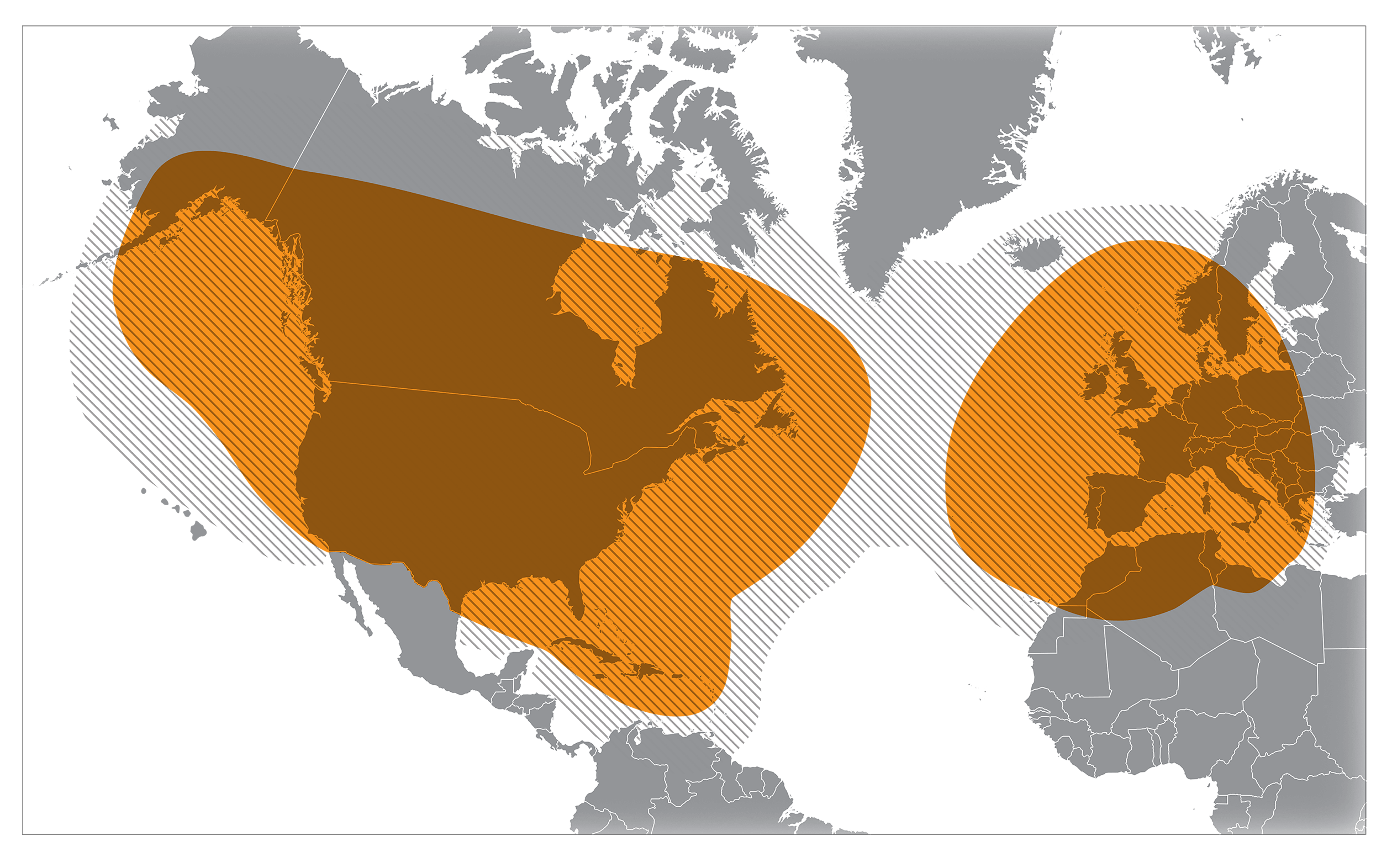

Advantages
Globalstar’s 24 ground stations serve as a bridge between LEO satellites and traditional communications infrastructure on six continents. This connection provides communications to over 120 countries throughout the world. The second generation ground infrastructure is based on the Internet protocol multimedia subsystem (IMS) configuration to allow Globalstar engineers to continually adapt to changing user needs.
All IP based and IMS solution uses an IP Multimedia Subsystem and facilitates the use of IP (Internet Protocol) for packet communications over wireless or landline. There are many advantages of the IP based IMS solution. Globalstar can offer richer and more features to customers, maximize use of satellite technology for optimal user experience, better mobile satellite service throughput for improved data connectivity delivering clear connections on the ground.

Ligado satellite network/MSAT
Ligado Networks brings together a one-of-a-kind satellite network and smart use of the mid-band spectrum to deliver ubiquitous coverage throughout North America. Ligado’s SkyTerra 1, one of the most powerful L-band commercial satellites ever built, uses the largest reflector-based antenna in commercial service—22 meters—to enable pervasive communications and high-quality mobile connections to low-power, small form-factor devices. Ligado’s ground-based beamforming technology allows hundreds of beams to be formed over SkyTerra 1’s coverage footprint when and where they are needed. These ground programmable beam shapes provide greater flexibility to allocate both coverage and capacity as necessary, for business scalability or in response to emergencies. Targeted power and bandwidth allocation makes for better management of overall network capacity as new beams can be created and added anytime to meet specific custom needs. And because Ligado’s system operates using mid-band spectrum, SkyTerra 1’s satellite network is not only less susceptible to rain fade or dense foliage but will also be tightly integrated with Ligado’s terrestrial network offerings to deliver seamless terrestrial-satellite coverage. SkyTerra 1 satellite provides coverage and capacity that can be dynamically allocated to respond to business needs for scalability or in response to emergencies. The advanced beamforming capabilities of the ground-based network provide greater flexibility in the management of network resources. SkyTerra 1 can form hundreds of beams when and where they are needed within Ligado North American footprint. And because the system operates using mid-band spectrum, Ligado’s satellite connectivity is not only less susceptible to rain fade or dense foliage but can also be tightly integrated with the Ligado terrestrial network offerings to deliver seamless terrestrial-satellite coverage.
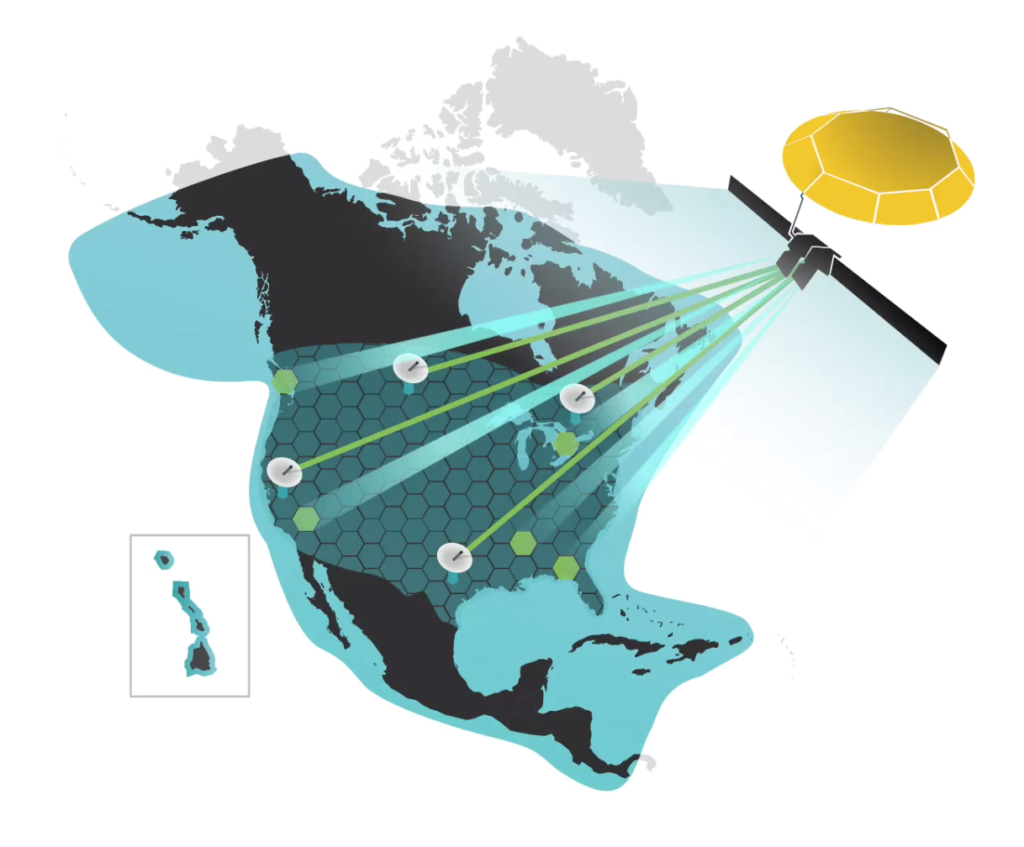
SkyTerra 1
- One-of-a-kind satellite network
- 22-meter, reflector-based antenna
- State-of-the-art capabilities, including ground-based beamforming and targeted bandwidth resource allocations
- Ideal for pervasive connectivity to small, fixed and mobile devices
- Enables stronger mobile connections and greater flexibility in network capacity management

